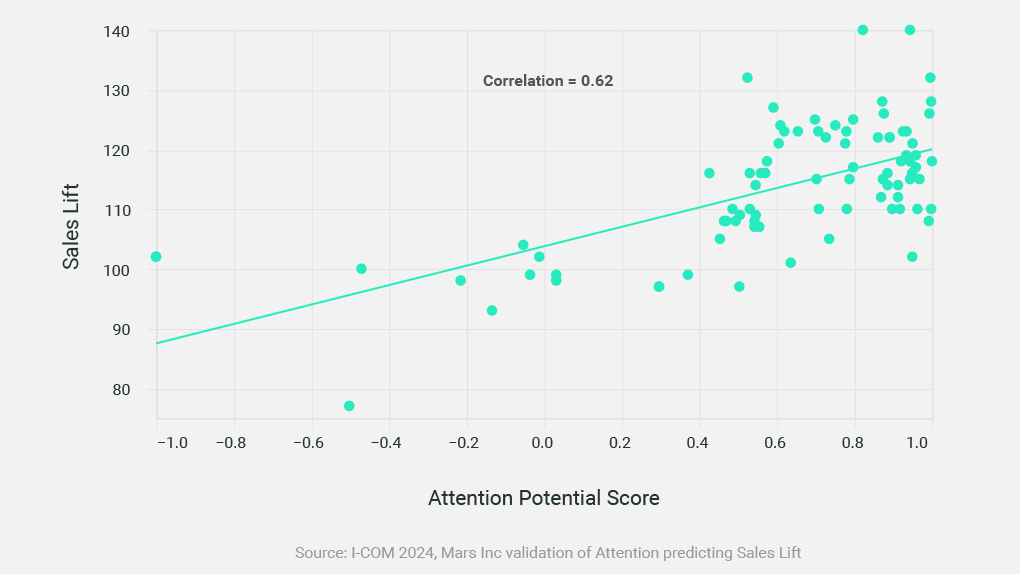Creative that connects with people performs better and costs less as a result. Advertisers can simultaneously lower CPMs and grow Sales by investing in creative quality.
Lowering CPM can seem at odds with the goal of driving sales, as it may suggest lower-quality impressions. However, by investing in creative quality and identifying what best engages the audience, brands can naturally reduce CPMs. Stronger creatives lead to better relevance, wider reach, and ultimately, more conversions aligning cost efficiency with sales growth.
Platforms have historically charged higher CPMs for less engaging ads. Tying “good” ads to sales is an ongoing challenge for advertisers. Realeyes has proven that using a single Creative Quality metric can forecast which creatives drive stronger sales and achieve lower CPMs. This is a clear win-win for advertisers who are mandated to manage costs without trading off effectiveness.
Executive Summary
- Creative Quality is the only lever to lower CPM while also improving sales
- Strong creative earns better CPMs because platforms reward engagement.
- On average, optimizing Creative Quality via Realeyes’ Attention Potential Score creates 40% more sales and 25% lower CPMs
Rethinking CPM
CPM is Not a Measure of Impact
CPM measures how often an ad was technically served., It does not measure whether the ad was seen by a real person, remembered, or contributed to business outcomes. CPM is a server-side metric, not a measure of human engagement. But as a direct lever on costs, monitoring and managing CPMs is critical to advertisers.

The Hidden Costs of Cheap Impressions
When tasked with reducing costs, marketers often focus on lowering CPMs. Problems arise when this is done without considering the quality of media placements. High-quality inventory, such as ads that are viewable, shown to real people, and placed in trusted environments, typically comes at a higher cost, for good reason. These ads benefit from smarter targeting, better formats, and access to limited premium space.
On the other hand, extremely low CPMs often indicate low-value impressions. These may be non-viewable placements, fraudulent traffic, or irrelevant environments designed to exploit loopholes in ad systems. Such ads may technically be delivered but rarely reach or influence real audiences.
Low CPM looks efficient on paper, but without impact, it's wasted spend.
When Metrics Mislead
Leadership teams that prioritize low CPMs often push media buyers toward the cheapest inventory available. This can lead to ads appearing in poor-quality placements that look efficient on paper but fail to make a real impact. The campaign meets its cost target, but not its business objectives.
Creative that connects with people performs better and costs less as a result.
Tactics That Lower CPM Can Lower Performance
Strategies that produce low CPMs often sacrifice effectiveness. Tactics like expanding reach to uninterested audiences or overloading the same users with frequency may reduce costs, but they rarely improve results. A wider reach might generate more impressions at a lower price, but often to people who have little interest or intent to engage.
Performance Over Price
A lower CPM only means you paid less to serve the ad. It doesn’t mean the ad worked. If impressions don’t drive recall, engagement, or action, then even the lowest CPM is wasted budget.
The most successful advertisers evaluate media spend not just by the cost of impressions, but by what those impressions deliver in return. Relevant and engaging creative , tends to perform better. Media platforms reward high-performing creative with better placement and lower CPMs.
Advertising success isn’t measured by the lowest cost per impression. It’s measured by the impressions that matter, which are those that reach the right audience and drive real results.
...successful advertisers evaluate media spend not just by the cost of impressions, but by what they return.
Attention Potential Score
Realeyes created the Attention Potential Score to provide greater context to an advertisement’s quality. It is a 0 –100 predictive rating that estimates how likely an ad is to drive sales. Mars for example has seen a 0.62 correlation between Attention Potential score and Sales – resulting in an 3-5% Sales Lift.
Multiple advertising partners have validated the inverse relationship between Attention Potential and CPM. One advertiser for example saw that just a 1% increase in Attention Potential would decrease CPM by 2.7%.
...a metric that can forecast which creatives will lower CPMs whilst drive stronger sales.

Frames
Audience views mapped to attention and emotion
Participants
Webcam observations of people watching
Ads
Biggest culturally sensitive training set over 90 countries

The score measures human attention (eyes on screen) and emotions (facial expressions) in response to creative content through first-party webcam studies. Built from 336 billion+ frames of viewing time mapped to attention and emotion data, collected from over 90,000 video ads and 18 million human participants.
This human data was modeled to create the Attention Potential Score, where the higher the score, the greater the sales outcomes and the lower the CPM. It’s the strongest signal to predict ad creative outcomes.
This scoring enables creative and media teams to gauge performance early in the process, refine content as needed, and make more confident decisions before launch.
...the strongest signal to predict ad creative outcomes.
Source: Realeyes 2025 analysis of +$1bn ad spend on +1,000 creatives on social platforms, across multiple advertisers, verticals and geographies
Creative: Most Powerful CPM Lever
Platform Goals Are Not Business Goals
Advertising platforms optimize for user engagement, not your sales. They can’t “see” your conversions, but they do prioritize attention. This makes creative quality the only lever that aligns advertiser ROI with platform incentives.
Other CPM Levers Have Limits
Advertisers often lower CPM through:
- Broader targeting
- Bid strategy tweaks
- Frequency caps
- Constant A/B testing
But only creative quality both lowers cost and boosts effectiveness. It’s also the only factor you can assess before launch, preventing wasted media spend.

Creative Quality Predicts ROI
How It Works
Think of Attention Potential as an ROI estimator, where:
- Sales uplift is the numerator
- CPM is the denominator
High creative quality increases engagement. This improves platform delivery, leading to more efficient media buying and better outcomes.

Creative Quality Lowers CPM
The Causal Link to Platform Efficiency
Engaging ads trigger positive feedback loops in platform algorithms:
- Better creative generates more attention.
- Platforms reward attention with better placements and cheaper impressions.
- High-performing ads maintain efficiency even at higher frequencies.
In contrast, weak creative leads to delivery penalties, reduced exposure and higher CPMs.
Endurance at Scale
Strong creatives don’t just earn attention, they sustain it. They are more resilient to wear out, especially during peak periods like holidays or product launches. This makes them more scalable and cost-efficient at higher volumes.

Applying Attention Potential
The Causal Link to Platform Efficiency
To harness Attention Potential, brands should:
- Calibrate: Map historical performance to scores to define benchmarks.
- Test: Use the score in early concepts such as animatics to final edits.
- Scale: Apply learnings across platforms, formats, and seasonal campaigns.
Over time, this creates a brand-specific playbook for high-performing creative.
Brands such as AXA, P&G, Mars and Nielsen have integrated Attention Potential score into their workflow.
AXA Example

- A 5% lift in Attention Potential score resulted in a 12% increase in new business generation.
- Creative Attention helps MMM predict ROI with a <10% margin of accuracy on tested market.
- The Attention Potential score explained 23% of AXA incremental new business generation.
- The Creative Attention threshold for positive business growth was 57/100 or above.
Relative, Not Absolute
One score does not fit all. A creative scoring 57 may outperform a 67 in a different brand category, product category, duration or media context. The value lies in learning what resonates with your audience and refining your approach accordingly.
Creative Playbooks
With the ability to be able to “test every ad” through PreView Synthetic, it enables advertisers to establish category specific norms, identify what creative attributes perform best to optimize future campaign strategies.
Conclusion
The singular pursuit of low CPM is a flawed strategy. True media efficiency comes not from buying impressions cheaply, but from making those impressions count.
Creative quality, measured through Attention Potential, offers a predictive, scalable, and validated way to drive both lower media costs and stronger business outcomes. In a landscape where most delivery variables are out of your control, creative remains your most powerful lever for performance.
"You're a surrogate for MMM that’s just as reliable at 1/10th of the cost."
– CPG Advertiser




